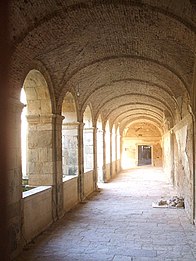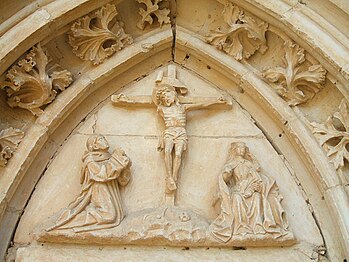Monastery of Santa María de Sandoval
- Machine translation, like DeepL or Google Translate, is a useful starting point for translations, but translators must revise errors as necessary and confirm that the translation is accurate, rather than simply copy-pasting machine-translated text into the English Wikipedia.
- Consider adding a topic to this template: there are already 931 articles in the main category, and specifying
|topic=will aid in categorization. - Do not translate text that appears unreliable or low-quality. If possible, verify the text with references provided in the foreign-language article.
- You must provide copyright attribution in the edit summary accompanying your translation by providing an interlanguage link to the source of your translation. A model attribution edit summary is
Content in this edit is translated from the existing Spanish Wikipedia article at [[:es:Monasterio de Santa María de Sandoval (Mansilla Mayor)]]; see its history for attribution. - You may also add the template
{{Translated|es|Monasterio de Santa María de Sandoval (Mansilla Mayor)}}to the talk page. - For more guidance, see Wikipedia:Translation.
| Monastery of Santa María de Sandoval | |
|---|---|
Monasterio de Santa María de Sandoval | |
 | |
| Religion | |
| Affiliation | Catholic Church |
| Province | León |
| Location | |
| Location | Villaverde de Sandoval |
| Municipality | Mansilla Mayor |
| Country |  Spain Spain |
| Architecture | |
| Completed | 15th century |
Santa María de Sandoval was a Roman Catholic monastery of the Cistercian Order in Spain from the 12th century until 1835. The oldest part was built in the Romanesque style, but later additions are Gothic. Today its ruins lie in Villaverde de Sandoval. It has been listed as a monumento histórico-artístico (historical artistic monument) since 3 June 1931.[1] In 2015, the Spanish government listed it as an "associated element" of the Camino de Santiago, a UNESCO World Heritage Site.[2]
In 1142, the Emperor Alfonso VII gave a piece of land to his majordomo, Count Ponce de Minerva. Known as Sotnoval or Saltus Novalis, it lay near the confluence of the rivers Porma and Esla a few miles outside the city of León. In 1167, Ponce and his wife, Estefanía Ramírez, with the consent of their children, Ramiro, María and Sancha, gave the land to Abbot Diego Martínez of the monastery of Santa María de la Santa Espina for the construction of a new Cistercian monastery. Monastic life began at Sandoval in 1171 with twelve monks from La Santa Espina under Abbot Diego. Although Sandoval began as a daughter house of La Santa Espina, in a short time it would equal its spiritual parent in importance.
Among Sandoval's early patrons was Urraca, daughter of Alfonso VII, whose anniversary mass was celebrated there on 25 June. The monastery received not only real property in donations, such as dehesas, but also feudal rights. In 1222, the monastery received land and dehesas from King Ferdinand III. It also had a small daughter house of its own at Valdellán.
After 1487, Sandoval became part of the Congregation of Castile, a group of reformed Spanish Cistercian houses founded by Martín de Vargas.
In 1835, the monks abandoned the monastery during the first confiscation of Mendizábal. It continued to be used as a parish church and services are still occasionally celebrated there.
-
 Central apse
Central apse -
 Exterior
Exterior -
 Cloisters
Cloisters -
 Portal
Portal
References

42°29′58″N 5°27′33″W / 42.4995°N 5.4593°W / 42.4995; -5.4593













